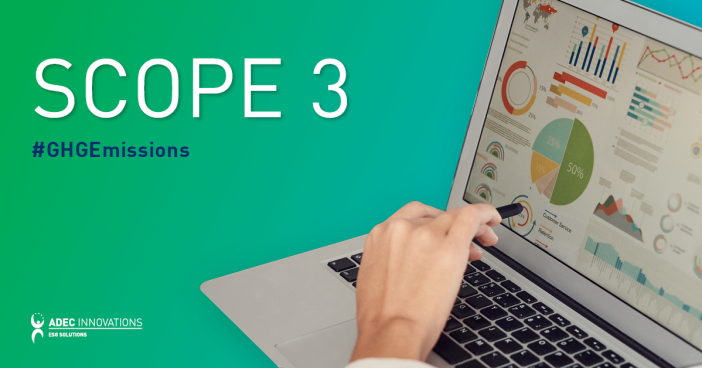Scope 3 emissions are indirect emissions that occur in the value chain, both upstream and downstream from your organization’s scope 1 and 2 emissions. Separate from scope 1 emissions (from owned or controlled sources) and scope 2 emissions (from purchased energy), scope 3 emissions often account for the majority of an organization’s total greenhouse gas (GHG) emissions. However, because they lie outside of an organization’s direct control, accounting for and mitigating scope 3 emissions can often present challenges.
The intent of the blog is to help readers understand where to begin and how to assess what scope 3 categories are relevant to their organization. To do this, we will use screening-level analysis using spend data (dollars spent in the scope 3 categories) to estimate scope 3 GHG emissions by category. While screening-level inventories are not ideal for downstream ESG purposes, such as target setting, strategy identification, or long-term performance monitoring, they do provide a rapid assessment and allow companies to determine which categories should be evaluated further in later tasks and stages.
1. Review scope 3 categories
The first step in understanding scope 3 emissions in your organization is to complete a review of the fifteen scope 3 categories identified in the Greenhouse Gas Protocol’s Corporate Value Chain (Scope 3) Accounting and Reporting Standard. These are broken down into upstream emissions (categories 1-8) and downstream emissions (categories 9-15).
Keep in mind that the GHG Protocol establishes minimum boundaries for each category to clarify what major activities within the value chain companies actually need to account for, as some categories may be excluded, provided that these are appropriately disclosed.
The goal of this step is to determine what scope 3 categories are relevant—or material—to your organization.

2. Conduct a boundary analysis
Next, conduct a boundary analysis with the relevant team members of your organization. It is important to bring in members of your organization that have a thorough understanding of the organization’s operations, facilities, and practices to accurately identify upstream and downstream emission sources within an organization’s boundaries. The relevant team members of your organization could include, but are not limited to, facility and real estate managers, purchasing and procurement managers, operations managers, and finance managers. Here, you’ll evaluate and determine where scope 3 emissions occur and which categories are potentially relevant, or material, to the organization through a screening analysis.
A screening analysis uses a spend-based model to determine GHG emissions per category based on dollars spent. You’ll need to work with relevant members of your team to gather financial data to begin categorizing scope 3 emissions, and there are available to speed up estimating emissions per scope 3 category.
The EPA has published emissions factors associated with dollars spent for each scope 3 category. The equation looks like this:
Dollars spent for given category x Emissions Factor for given category = Estimated emissions
In the following example, we’ll use this equation as a part of our screening analysis to determine estimated emissions for a given scope 3 category.
Let’s assume the following:
Scope 3 category analyzed: Category 2 Purchased Goods and Services: Computer and Electronic Products
Emissions factor: 0.0927 kg CO2e/2021 USD
USD spent on “Computer and Electronic Products”: $1,000,000 USD
Our equation would look like this:
$1,000,000 USD
x
0.0927 kg CO2e/2021 USD
= 92,678.41kg CO2e from Category 2 Purchased Goods and Services: Computer and Electronic Products
Seeking third-party support
Alternatively, organizations often work with a third party to develop their GHG inventory, as technical experts can help streamline the inventory process, identify gaps, and offer additional insight into how to get the most out of your data.
3. Conduct a relevancy analysis
The next step is to conduct a relevancy analysis. The GHG Protocol identifies six criteria for determining whether a scope 3 category is relevant as described below.
- Size. Category activities contribute significantly to the company’s total anticipated scope 3 emissions.
- Influence. There are potential emissions reductions that could be undertaken or influenced by the company.
- Risk. Activities within the category contribute to the company’s climate change-related risk exposure (e.g. financial, regulatory, supply chain, product and customer, litigation, and reputational risks).
- Stakeholders. Category is deemed critical by key stakeholders.
- Outsourcing. Category includes outsourced activities previously performed in-house or outsourced activities that are typically performed in-house by other companies in the reporting company’s sector.
- Sector guidance. Category has been identified as significant by sector-specific guidance.
- Other. Category meets additional criteria for determining relevance developed by the company and/or industry sector.
Once categories are deemed to be relevant or irrelevant (material or immaterial), further refining and specific categorization of emissions should be performed to enhance the quality of the GHG estimations. This could include further separating out purchases into more precise subcategories or using supplier specific emissions factors to get a more accurate estimation of scope 3 emissions.
Scope 3 GHG emissions are receiving increased interest from investors, consumers, and governments alike. Though seemingly daunting, contemporary methods for analyzing scope 3 GHG emissions have made it possible for organizations of all sizes to begin tracking their scope 3 inventory.
ADEC ESG Solutions is a leading provider of sustainability solutions, including fully-integrated industry expertise, software solutions, and data management. Click here to learn more about how our team can help you track and manage ESG data, set targets, and integrate sustainability into your strategy.




